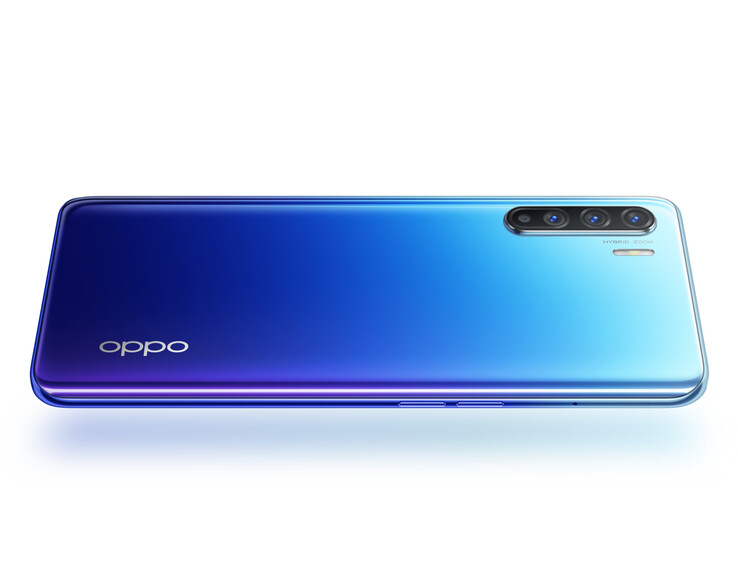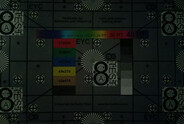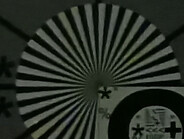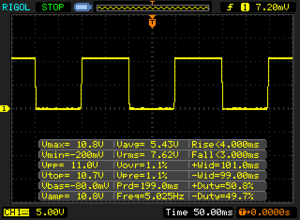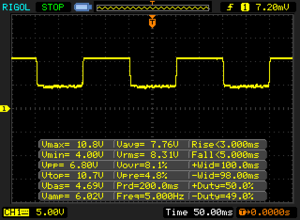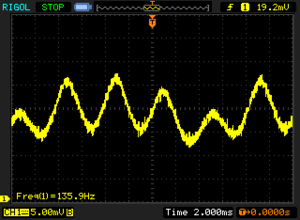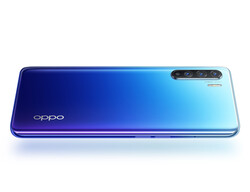Oppo Reno3智能手机评测:摄像头多还不贵
Comparison devices
Bewertung | Rating Version | Datum | Modell | Gewicht | Laufwerk | Groesse | Aufloesung | Preis ab |
|---|---|---|---|---|---|---|---|---|
| 80.1 % v7 (old) | v7 (old) | 08 / 2020 | Oppo Reno3 Helio P90, PowerVR GM9446 | 170 g | 128 GB UFS 2.1 Flash | 6.40" | 2400x1080 | |
| 81.2 % v7 (old) | v7 (old) | 10 / 2019 | Oppo Reno2 SD 730G, Adreno 618 | 189 g | 256 GB UFS 2.0 Flash | 6.50" | 2400x1080 | |
| 81.6 % v7 (old) | v7 (old) | 09 / 2019 | Xiaomi Mi 9T SD 730, Adreno 618 | 191 g | 64 GB UFS 2.0 Flash | 6.39" | 2340x1080 | |
| 80.3 % v7 (old) | v7 (old) | 12 / 2019 | Motorola One Hyper SD 675, Adreno 612 | 210 g | 128 GB UFS 2.0 Flash | 6.50" | 2340x1080 |
» Notebookcheck多媒体笔记本电脑Top 10排名
» Notebookcheck游戏笔记本电脑Top 10排名
» Notebookcheck低价办公/商务笔记本电脑Top 10排名
» Notebookcheck高端办公/商务笔记本电脑Top 10排名
» Notebookcheck工作站笔记本电脑Top 10排名
» Notebookcheck亚笔记本电脑Top 10排名
» Notebookcheck超级本产品Top 10排名
» Notebookcheck变形本产品Top 10排名
» Notebookcheck平板电脑Top 10排名
» Notebookcheck智能手机Top 10排名
» Notebookcheck评测过最出色的笔记本电脑屏幕
» Notebookcheck售价500欧元以下笔记本电脑Top 10排名
» Notebookcheck售价300欧元以下笔记本电脑Top 10排名
Size comparison
| Networking | |
| iperf3 transmit AX12 | |
| Oppo Reno2 | |
| Oppo Reno3 | |
| Motorola One Hyper | |
| Xiaomi Mi 9T | |
| iperf3 receive AX12 | |
| Oppo Reno2 | |
| Oppo Reno3 | |
| Motorola One Hyper | |
| Xiaomi Mi 9T | |
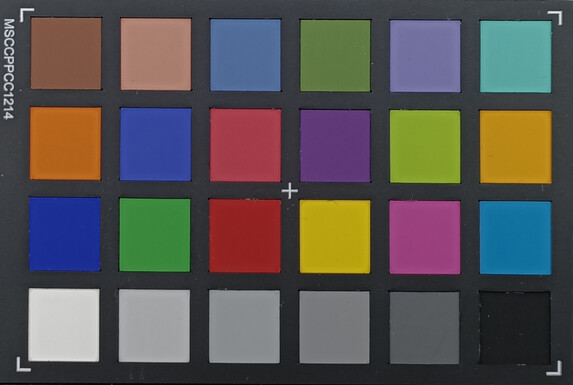
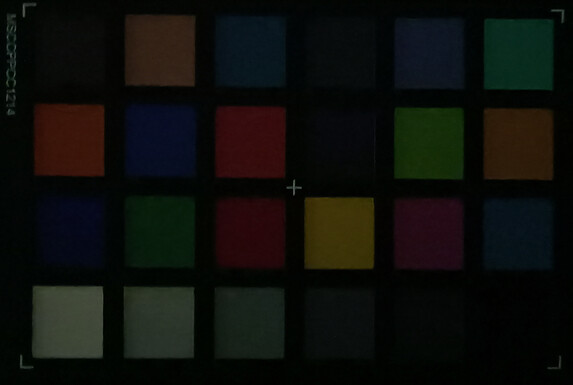
| |||||||||||||||||||||||||
Brightness Distribution: 90 %
Center on Battery: 595 cd/m²
Contrast: ∞:1 (Black: 0 cd/m²)
ΔE ColorChecker Calman: 4.96 | ∀{0.5-29.43 Ø4.78}
ΔE Greyscale Calman: 4.2 | ∀{0.09-98 Ø5}
100% sRGB (Calman 2D)
Gamma: 2.307
CCT: 7072 K
| Oppo Reno3 AMOLED, 2400x1080, 6.4" | Oppo Reno2 AMOLED, 2400x1080, 6.5" | Xiaomi Mi 9T AMOLED, 2340x1080, 6.4" | Motorola One Hyper IPS, 2340x1080, 6.5" | |
|---|---|---|---|---|
| Response Times | 55% | 52% | -332% | |
| Response Time Grey 50% / Grey 80% * (ms) | 8 ? | 3.6 ? 55% | 4 ? 50% | 44 ? -450% |
| Response Time Black / White * (ms) | 7 ? | 3.2 ? 54% | 3.2 ? 54% | 22 ? -214% |
| PWM Frequency (Hz) | 136 | 260.4 ? | 245.1 ? | 2404 ? |
| Screen | 14% | 27% | -2% | |
| Brightness middle (cd/m²) | 595 | 679 14% | 589 -1% | 455 -24% |
| Brightness (cd/m²) | 598 | 683 14% | 589 -2% | 444 -26% |
| Brightness Distribution (%) | 90 | 98 9% | 96 7% | 78 -13% |
| Black Level * (cd/m²) | 0.53 | |||
| Colorchecker dE 2000 * | 4.96 | 3.5 29% | 2.5 50% | 3.86 22% |
| Colorchecker dE 2000 max. * | 8.54 | 6.8 20% | 4.9 43% | 6.59 23% |
| Greyscale dE 2000 * | 4.2 | 4.2 -0% | 1.6 62% | 4 5% |
| Gamma | 2.307 95% | 2.27 97% | 2.24 98% | 2.3 96% |
| CCT | 7072 92% | 6532 100% | 6544 99% | 7367 88% |
| Contrast (:1) | 858 | |||
| Total Average (Program / Settings) | 35% /
24% | 40% /
33% | -167% /
-85% |
* ... smaller is better
Display Response Times
| ↔ Response Time Black to White | ||
|---|---|---|
| 7 ms ... rise ↗ and fall ↘ combined | ↗ 4 ms rise | |
| ↘ 3 ms fall | ||
| The screen shows very fast response rates in our tests and should be very well suited for fast-paced gaming. In comparison, all tested devices range from 0.1 (minimum) to 240 (maximum) ms. » 20 % of all devices are better. This means that the measured response time is better than the average of all tested devices (20.2 ms). | ||
| ↔ Response Time 50% Grey to 80% Grey | ||
| 8 ms ... rise ↗ and fall ↘ combined | ↗ 3 ms rise | |
| ↘ 5 ms fall | ||
| The screen shows fast response rates in our tests and should be suited for gaming. In comparison, all tested devices range from 0.165 (minimum) to 636 (maximum) ms. » 19 % of all devices are better. This means that the measured response time is better than the average of all tested devices (31.6 ms). | ||
Screen Flickering / PWM (Pulse-Width Modulation)
| Screen flickering / PWM detected | 136 Hz | ||
The display backlight flickers at 136 Hz (worst case, e.g., utilizing PWM) . The frequency of 136 Hz is very low, so the flickering may cause eyestrain and headaches after extended use. In comparison: 53 % of all tested devices do not use PWM to dim the display. If PWM was detected, an average of 8108 (minimum: 5 - maximum: 343500) Hz was measured. | |||
| PCMark for Android | |
| Work performance score (sort by value) | |
| Oppo Reno3 | |
| Oppo Reno2 | |
| Xiaomi Mi 9T | |
| Motorola One Hyper | |
| Average Mediatek Helio P90 (8736 - 13156, n=2) | |
| Work 2.0 performance score (sort by value) | |
| Oppo Reno3 | |
| Oppo Reno2 | |
| Xiaomi Mi 9T | |
| Motorola One Hyper | |
| Average Mediatek Helio P90 (7129 - 9654, n=3) | |
| GFXBench | |
| on screen Aztec Ruins Normal Tier Onscreen (sort by value) | |
| Oppo Reno3 | |
| Oppo Reno2 | |
| Xiaomi Mi 9T | |
| Motorola One Hyper | |
| Average Mediatek Helio P90 (6.5 - 9.3, n=3) | |
| Average of class Smartphone (6.2 - 166, n=211, last 2 years) | |
| 1920x1080 Aztec Ruins Normal Tier Offscreen (sort by value) | |
| Oppo Reno3 | |
| Oppo Reno2 | |
| Xiaomi Mi 9T | |
| Motorola One Hyper | |
| Average Mediatek Helio P90 (6.4 - 11, n=3) | |
| Average of class Smartphone (3.4 - 367, n=211, last 2 years) | |
| on screen Aztec Ruins High Tier Onscreen (sort by value) | |
| Oppo Reno3 | |
| Oppo Reno2 | |
| Xiaomi Mi 9T | |
| Motorola One Hyper | |
| Average Mediatek Helio P90 (3.5 - 5.8, n=3) | |
| Average of class Smartphone (0.85 - 144, n=212, last 2 years) | |
| 2560x1440 Aztec Ruins High Tier Offscreen (sort by value) | |
| Oppo Reno3 | |
| Oppo Reno2 | |
| Xiaomi Mi 9T | |
| Motorola One Hyper | |
| Average Mediatek Helio P90 (2.4 - 4.3, n=3) | |
| Average of class Smartphone (1.2 - 129, n=211, last 2 years) | |
| Oppo Reno3 | Oppo Reno2 | Xiaomi Mi 9T | Motorola One Hyper | Average 128 GB UFS 2.1 Flash | Average of class Smartphone | |
|---|---|---|---|---|---|---|
| AndroBench 3-5 | 151% | -12% | 158% | 195% | 330% | |
| Sequential Read 256KB (MB/s) | 504 | 469.3 -7% | 492.7 -2% | 492.2 -2% | 761 ? 51% | 2226 ? 342% |
| Sequential Write 256KB (MB/s) | 227.3 | 201.8 -11% | 179.2 -21% | 190.8 -16% | 296 ? 30% | 1848 ? 713% |
| Random Read 4KB (MB/s) | 127.3 | 144.2 13% | 128.6 1% | 129.4 2% | 154 ? 21% | 295 ? 132% |
| Random Write 4KB (MB/s) | 143.9 | 22 -85% | 107.8 -25% | 106.9 -26% | 130.4 ? -9% | 335 ? 133% |
| Sequential Read 256KB SDCard (MB/s) | 13.4 ? | 74.5 ? 456% | 74.3 ? 454% | 76 ? 467% | ||
| Sequential Write 256KB SDCard (MB/s) | 8.4 ? | 53.5 ? 537% | 53.6 ? 538% | 59.6 ? 610% |
(-) The maximum temperature on the upper side is 45.3 °C / 114 F, compared to the average of 35.2 °C / 95 F, ranging from 21.9 to 247 °C for the class Smartphone.
(±) The bottom heats up to a maximum of 43.8 °C / 111 F, compared to the average of 34 °C / 93 F
(+) In idle usage, the average temperature for the upper side is 29.1 °C / 84 F, compared to the device average of 32.9 °C / 91 F.
Oppo Reno3 audio analysis
(+) | speakers can play relatively loud (82.5 dB)
Bass 100 - 315 Hz
(-) | nearly no bass - on average 65.6% lower than median
(+) | bass is linear (0% delta to prev. frequency)
Mids 400 - 2000 Hz
(-) | nearly no mids - on average 65.6% lower than median
(+) | mids are linear (0% delta to prev. frequency)
Highs 2 - 16 kHz
(-) | nearly no highs - on average 65.6% lower than median
(+) | highs are linear (0% delta to prev. frequency)
Overall 100 - 16.000 Hz
(-) | overall sound is not linear (126.2% difference to median)
Compared to same class
» 96% of all tested devices in this class were better, 3% similar, 1% worse
» The best had a delta of 11%, average was 35%, worst was 134%
Compared to all devices tested
» 99% of all tested devices were better, 1% similar, 0% worse
» The best had a delta of 4%, average was 24%, worst was 134%
Oppo Reno2 audio analysis
(+) | speakers can play relatively loud (87.5 dB)
Bass 100 - 315 Hz
(-) | nearly no bass - on average 26.3% lower than median
(±) | linearity of bass is average (13.2% delta to prev. frequency)
Mids 400 - 2000 Hz
(+) | balanced mids - only 4.7% away from median
(+) | mids are linear (3.7% delta to prev. frequency)
Highs 2 - 16 kHz
(±) | higher highs - on average 7.7% higher than median
(+) | highs are linear (3.2% delta to prev. frequency)
Overall 100 - 16.000 Hz
(±) | linearity of overall sound is average (21.6% difference to median)
Compared to same class
» 43% of all tested devices in this class were better, 8% similar, 50% worse
» The best had a delta of 11%, average was 35%, worst was 134%
Compared to all devices tested
» 60% of all tested devices were better, 7% similar, 33% worse
» The best had a delta of 4%, average was 24%, worst was 134%
| Oppo Reno3 4025 mAh | Oppo Reno2 4000 mAh | Xiaomi Mi 9T 4000 mAh | Motorola One Hyper 4000 mAh | Average of class Smartphone | |
|---|---|---|---|---|---|
| Battery Runtime | |||||
| WiFi Websurfing (h) | 13.4 | 10.3 -23% | 16.5 23% | 12.6 -6% | 19.3 ? 44% |
Pros
Cons
总结——讨喜且耐用
Oppo Reno3
- 09/03/2022 v7 (old)
Florian Schmitt




